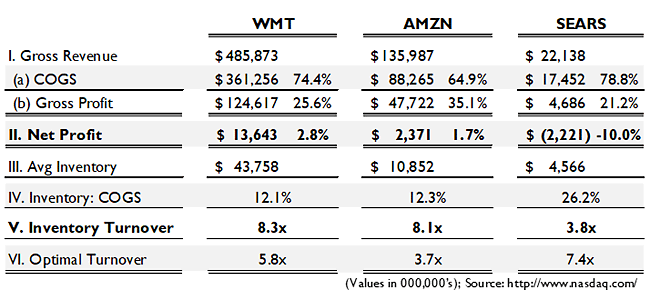Despite the recent record setting bull market, slower growth is becoming the new normal for a large portion of the retail sector. Competing reports outline strong holiday sales, while others maintain apocalyptic predictions. Retailers that are now flush with cash are shifting strategies into omni-channel development and experiential retail, while others are assessing the cost of bankruptcy. Even current headlines are highlighting department-store stabilization, yet there is little focus on their in-line counterparts that are quietly foregoing lease renewals.
Not only do Walmart and Amazon dominate the retail landscape, but both have become recognized for leading the massive disruption in customer buying patterns and altering the value-versus-price dynamic. The outcome of their aggressive pricing strategies is making it increasingly more difficult for competitors to survive under their current operating models, even those expected to be around forever. For retailers with overleveraged balance sheets, their downfall may look like dominoes falling over the next decade. But for those bankable retailers open to changing structural and operating strategies, their chances of survival in an evolving landscape remain strong.
Inventory Turnover and the Value of Controlling Operational Metrics
While it is prudent for retailers to take a holistic approach to managing operational metrics, oftentimes the myopic focus remains on the bottom line. This view can distort the more effective strategy that drives the success of Walmart and Amazon.
The financial snapshot below outlines the comparative financial health and inventory metrics of Walmart, Amazon and Sears, as of earnings reported in January 2017. Take note of the inventory turn rates of each retailer, particularly in conjunction with their inventory-to-COGS efficiency and net profitability.

These figures paint a striking picture of the operational strategy differences of these retailers and where their focus arguably lies. Walmart and Amazon both had inventory turn rates of 8.3x and 8.1x respectively while maintaining relatively high COGS with efficient inventory levels. What is particularly revealing, however, is the low net margin. What this shows is that to drive dollar value profit, Walmart and Amazon focus their operating models on turning inventory as rapidly as possible over a given cycle by constantly adjusting pricing strategies. Under this controlled diminished-profitability model, in conjunction with tight budgeting and strict break-even management, Walmart and Amazon will remain profitable and invariably beat any competitors on price.
When comparing both retailers’ success to the downfall of Sears, other factors are excluded. What is notable, for instance, is that while Sears’ COGS is only 4.4% in variance of Walmart, Walmart generated 4.5x more inventory turns. With a 26.2% inventory-to-COGS, what this reveals is that Sears is overloaded with too much inventory for their current pricing model and turnover rate. Guided by the metrics presented, their only chance of survival is to increase prices and sales to drive down the cost of goods, or else purge a significant amount of inventory and increase turnover.
Using Optimal Inventory Turnover to Adapt and Compete
The last line of the chart represents the Optimal Inventory Turnover rate of the respective retailers. Optimal turnover is a metric isolated by a retailer’s current COGS ratio as related to its Gross Profit ratio. It can be used as a benchmark to determine variances from actual turnover. Identification can help with markup strategy planning, foresight of future cash flow tightening, and a potential need to sell off excess merchandise.
As the chart reveals, whereas Walmart and Amazon both exceed their optimal turnover, Sears does not come close. For a typical retailer 3.8x inventory turns would be healthy but not with 78.8% COGS. Under the current COGS ratio, in order to reach an optimal turnover level, Sears would have to either decrease their current inventory by $1,616 or have sales of $37,407. Given that these scenarios are unrealistic, what this shows is that Sears has tightened cash flow and is rapidly approaching necessary liquidation.
What Pays for Lenders to Look Out for in Due Diligence
Prior to lending to an inventory-driven business or executing an inventory-backed loan, or even during inventory monitoring, it is prudent for financial institutions to assess their borrowers actual inventory turnover benchmarked against the optimal turnover. As a step beyond the necessity of a comprehensive appraisal, an understanding of a retailer’s turnover rates will help identify current or potential red flags that can compromise the value of the inventory. The book value of a retailer’s inventory is typically based on how expensive the inventory is at the time of purchase. However, if a retailer shows low inventory turnover or high variance from optimal turnover, older merchandise may be both building up and depreciating in value. The retailer may be tying up cash in inventory that is not selling in a reasonable timeframe while drawing on a line of credit to buy new inventory or fund cash flow shortages.
If this scenario ultimately triggers liquidation, it should come as no surprise that recovery rates could be compromised and the results lower than expected. While financial institutions may have a healthy 50% advance on inventory, if older, depreciated inventory does not get sold in a timely manner during normal business, it may be discovered that recovering 50% can present a challenge during liquidation.